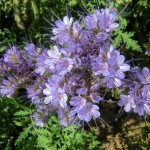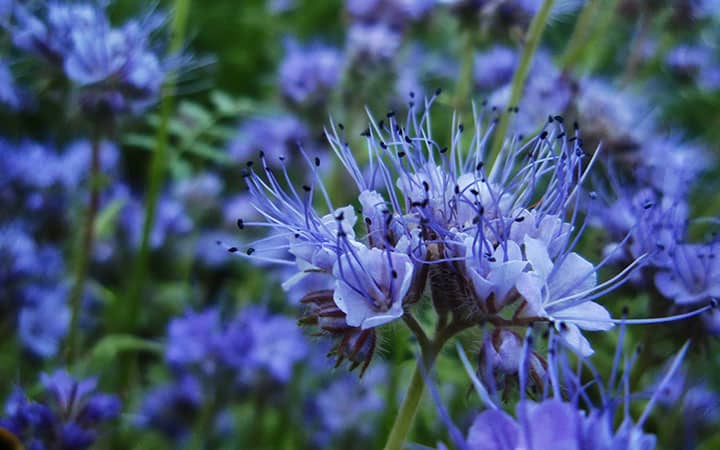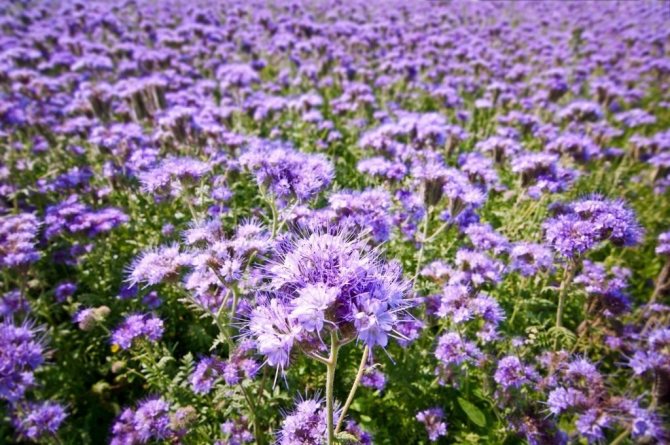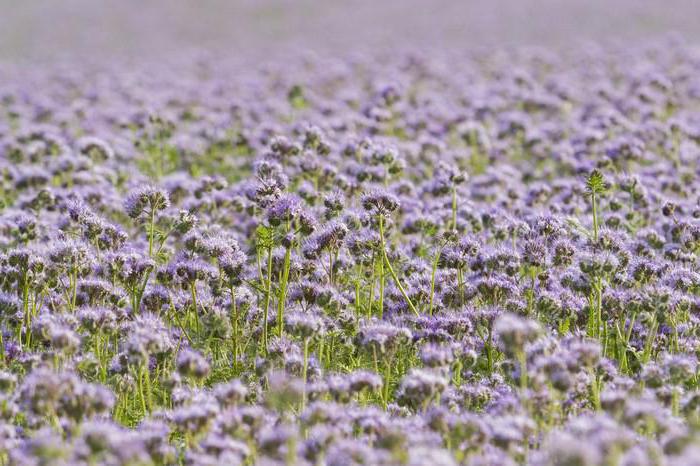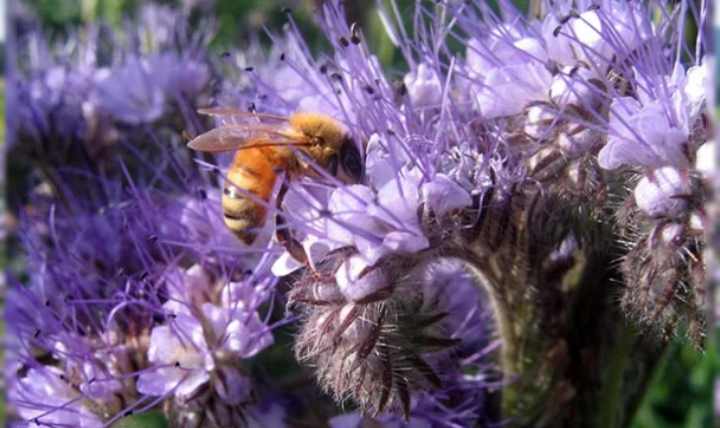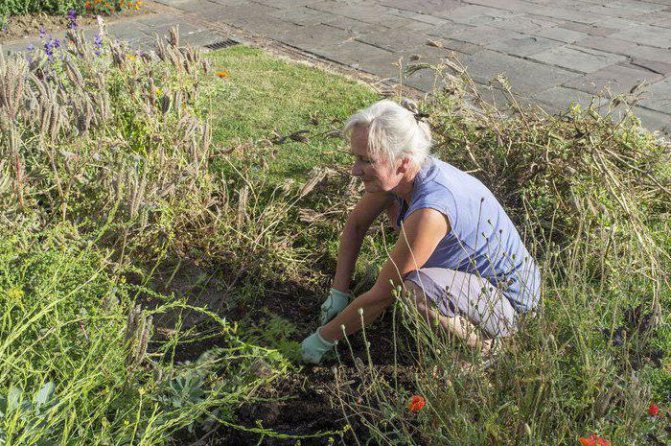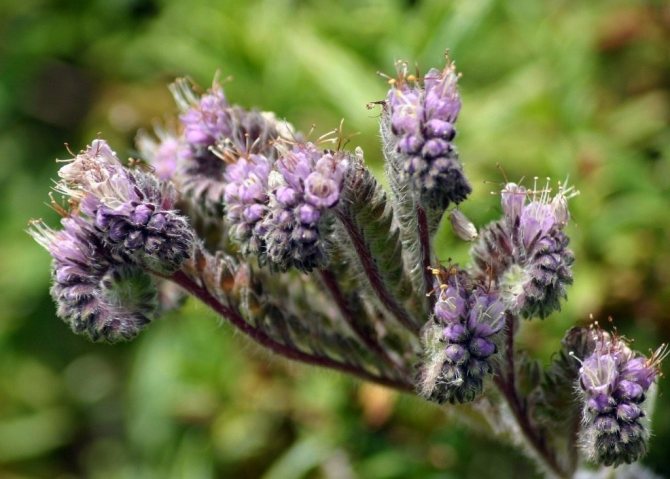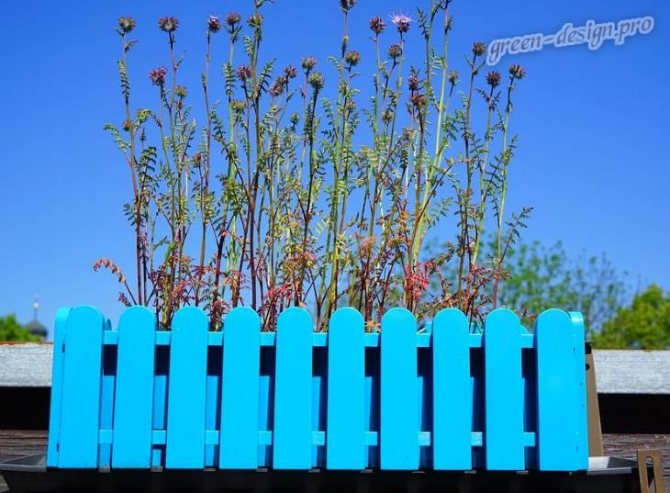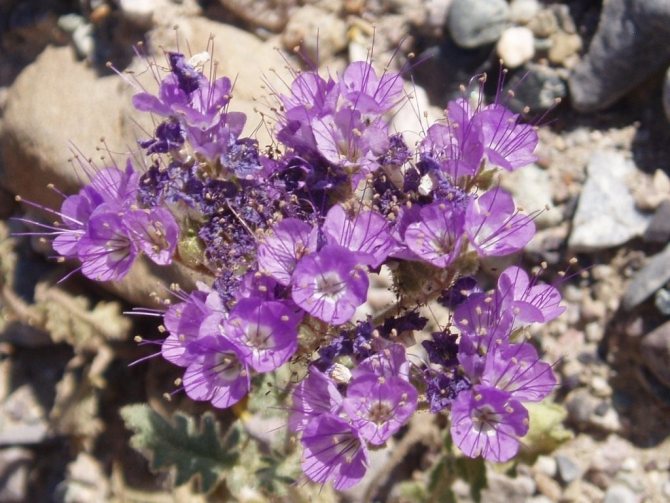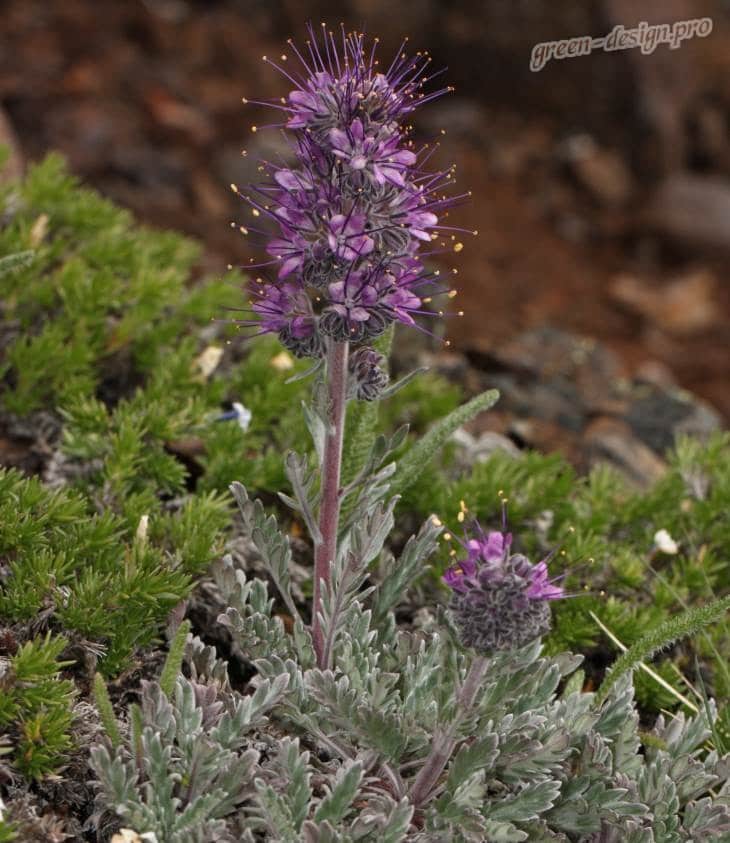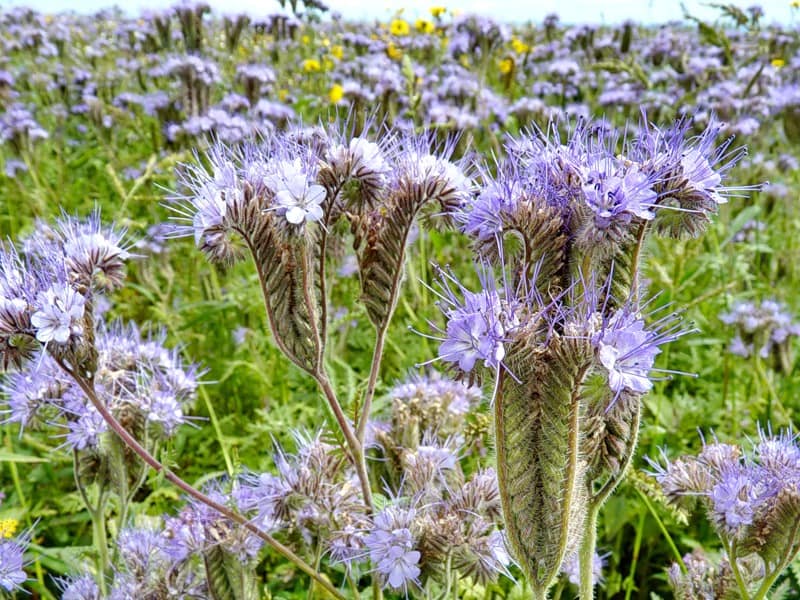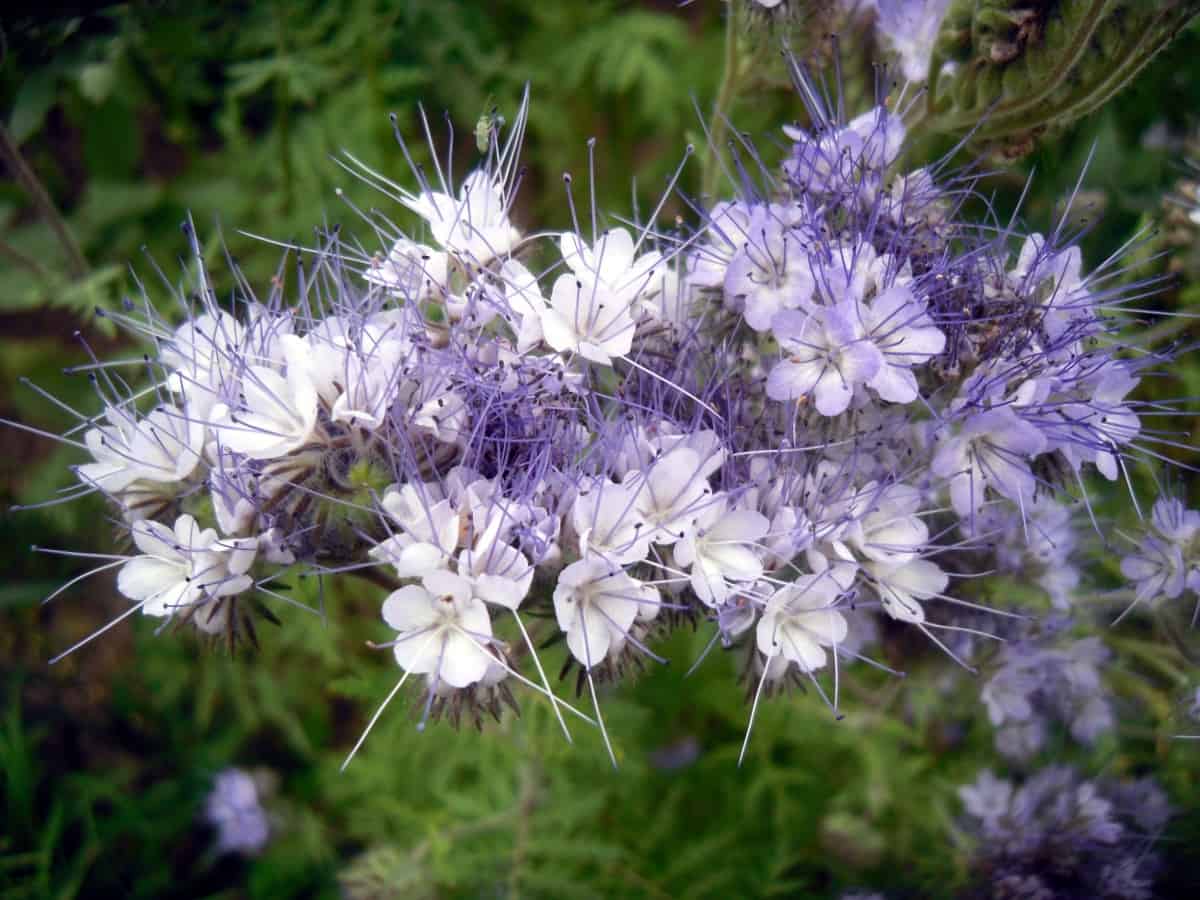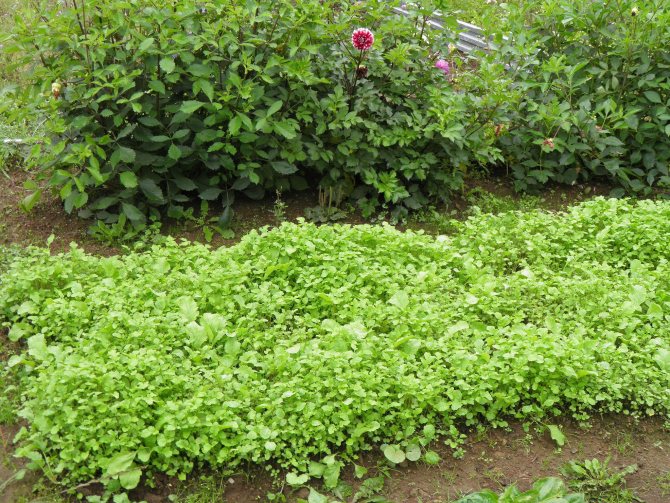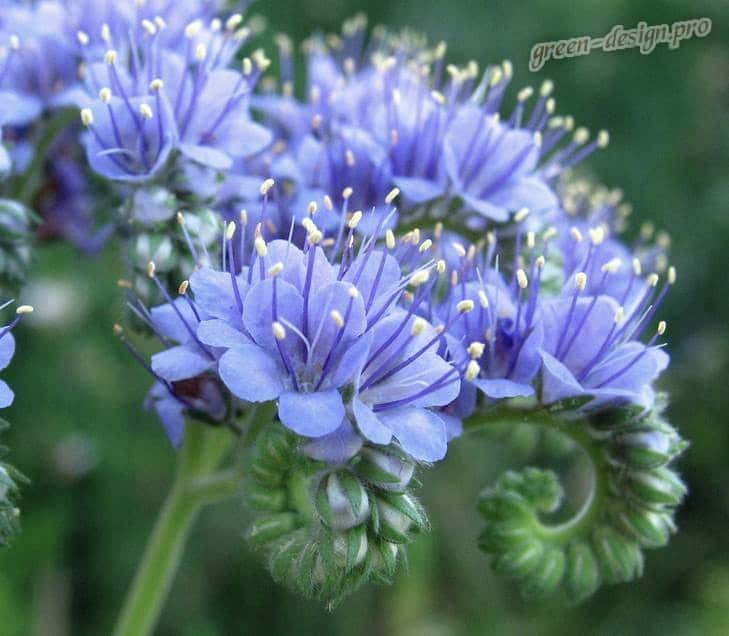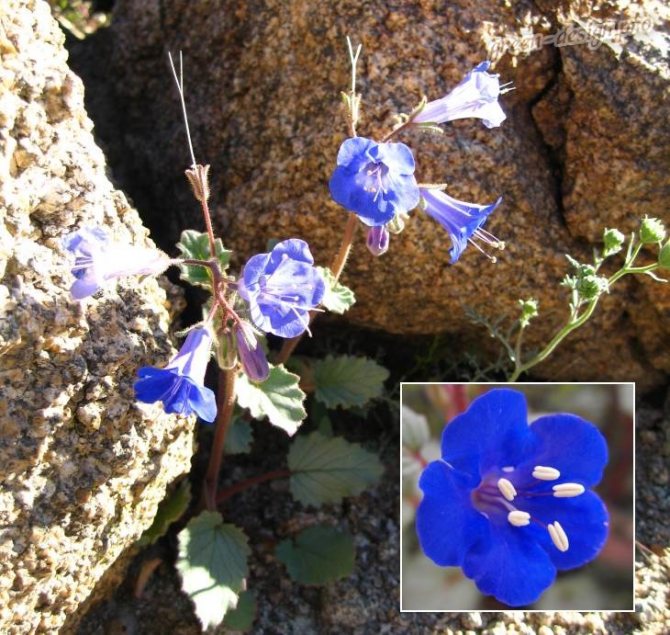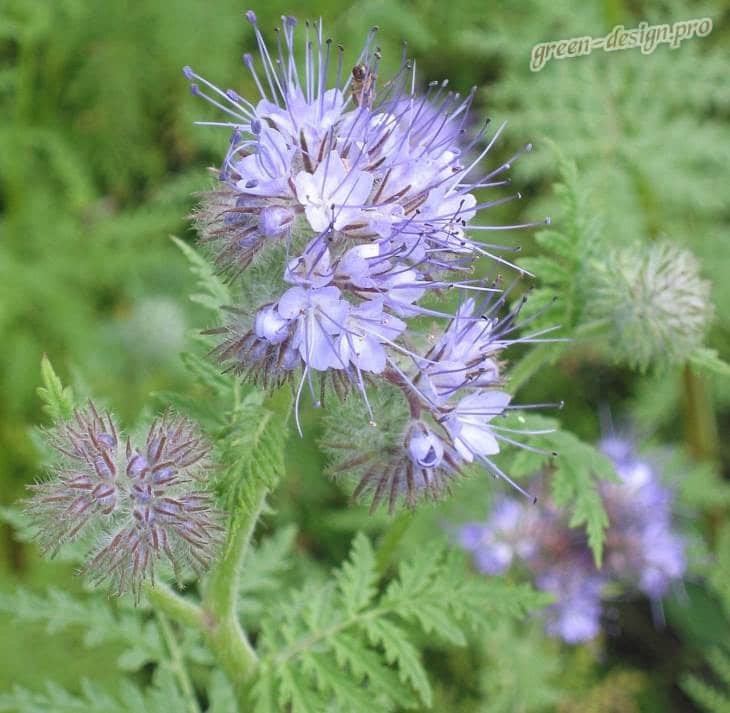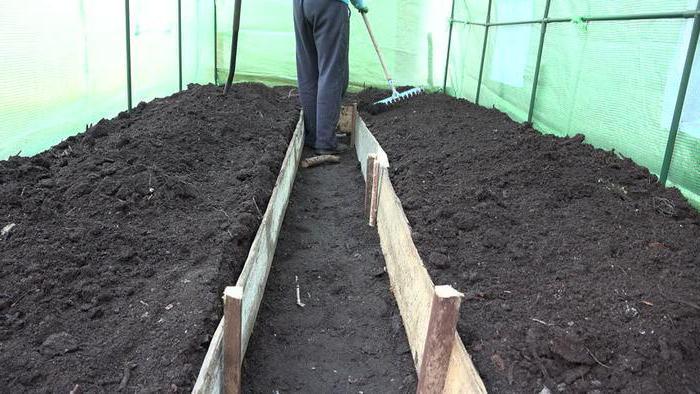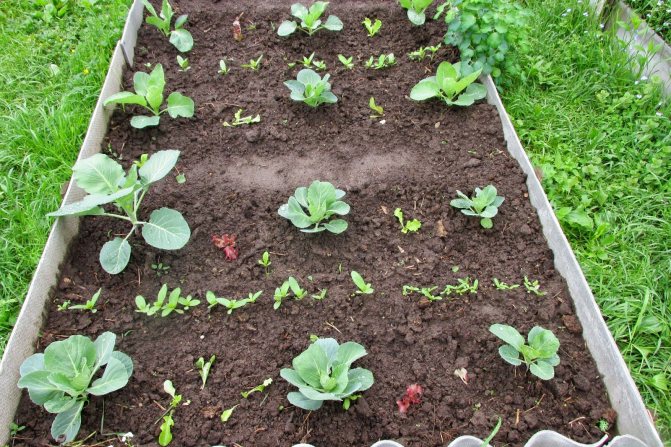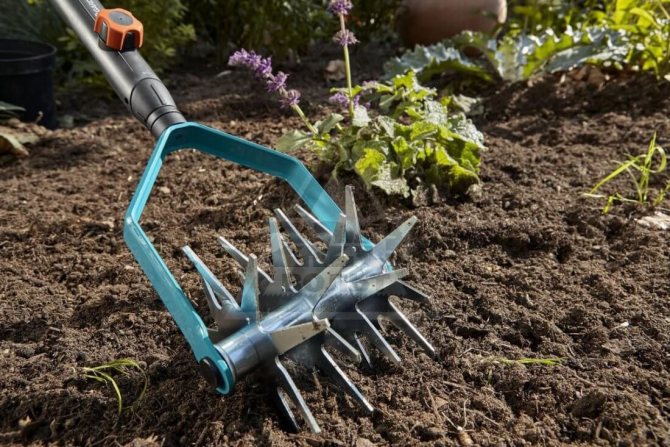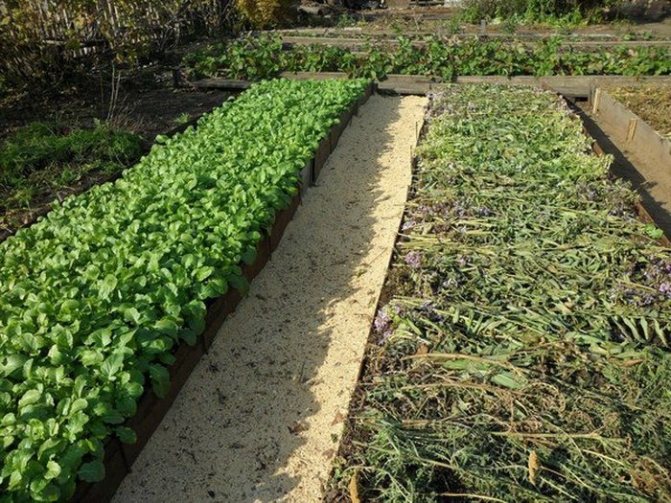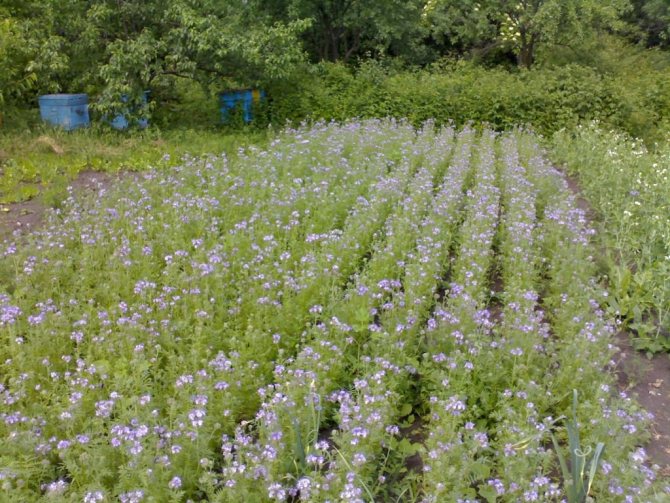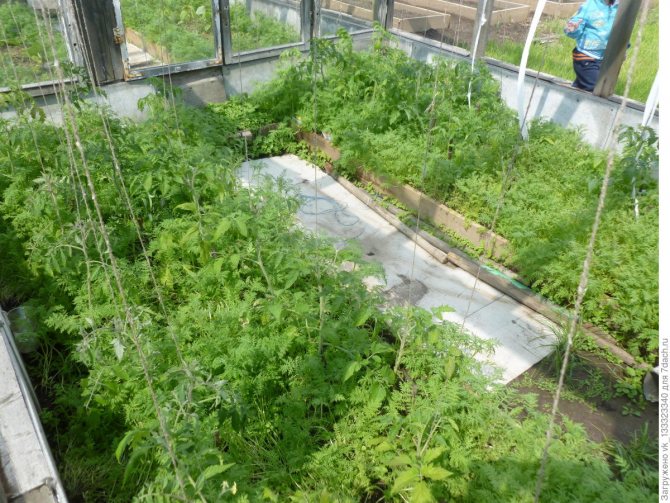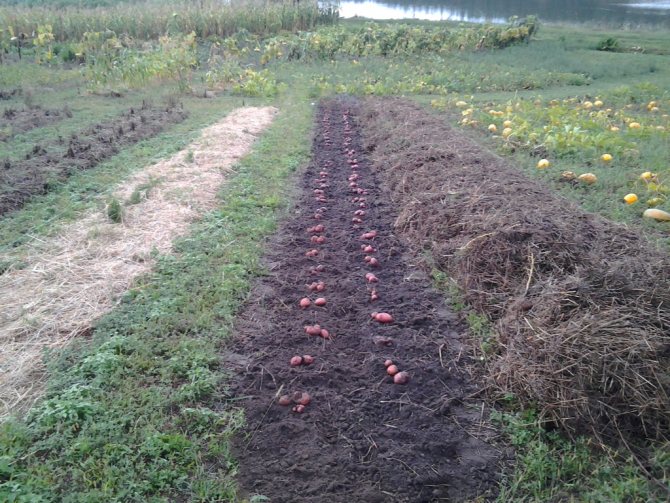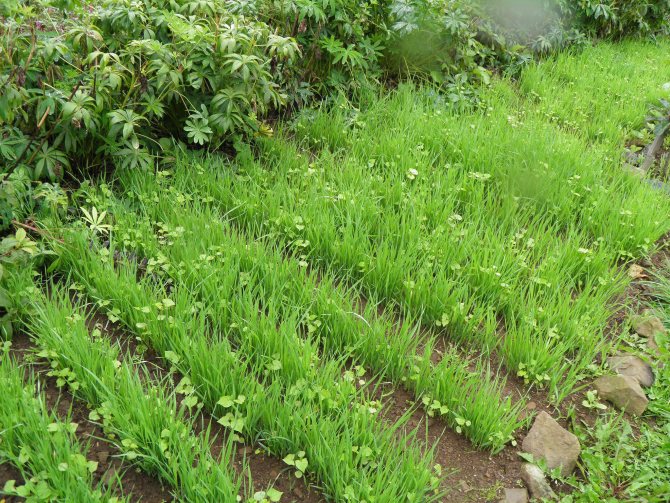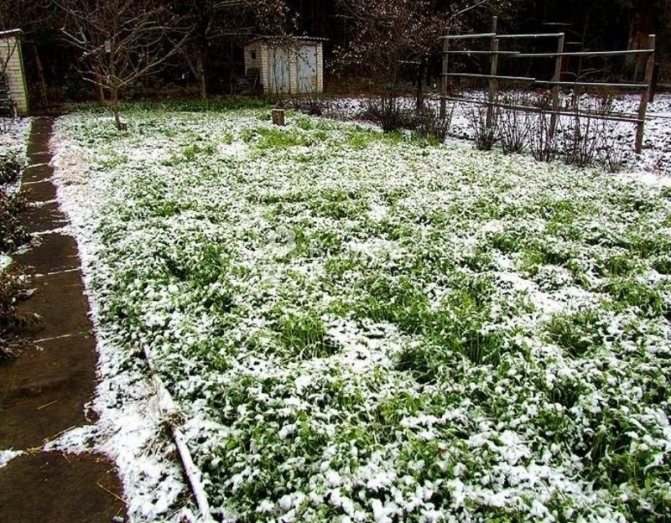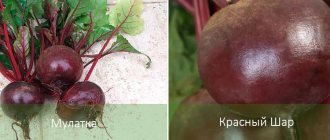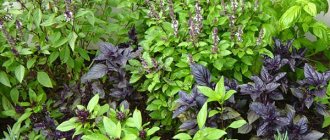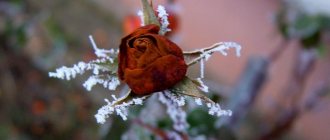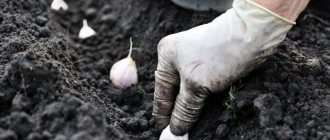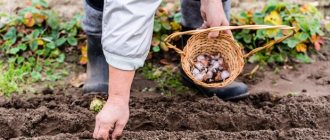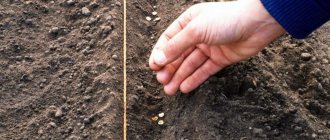Benefits of using phacelia
Phacelia is an annual plant from the hydrophilic (hydrophilic) family. Let's consider how to use phacelia as a green manure, and what are the benefits of using it.
What is the value
Phacelia green manure herb is interesting for farmers because it is suitable for growing on any type of soil and in different climatic conditions.
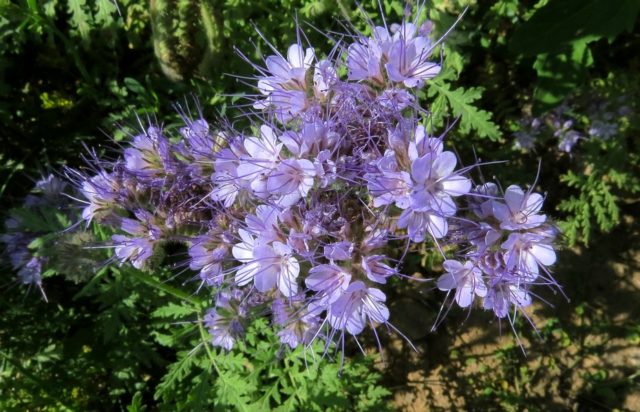
Phacelia is a versatile and unpretentious green manure
The main beneficial properties of phacelia green manure are as follows:
- in a short time, it gains a tangible green mass - in a month and a half from one hundred square meters, up to 300 kg of greens is obtained;
- its delicate leaves and stems quickly rot in the ground;
- Phacelia is a very useful and nutritious food for pets and birds;
- This herb is one of the best honey plants: from one hectare of phacelia, bees can collect more than 250 kg of honey.
Benefits for soil and plants
Due to its properties, phacelia brings significant benefits to both the soil and the plants planted after it or next to it:
- Phacelia perfectly loosens the soil, saturates it with air and moisture;
- gives a light and free-flowing structure even to heavy chernozems and clay soils;
- prevents weeds from growing;
- normalizes soil acidity;
- rotted green mass provides plants with nitrogen and organic matter, perfectly replacing manure;
- attracts insects, thanks to which pollination of cultivated plants improves and the number of ovaries increases;
- prevents the appearance of fungal (root rot), viral (late blight) and other plant diseases;
- proximity to phacelia leads to the disappearance of wireworms, kidney nematodes and even locusts;
- numerous predatory insects that flock to the phacelia nectar eat apple flower beetles, moths, leaf rollers and other garden pests.
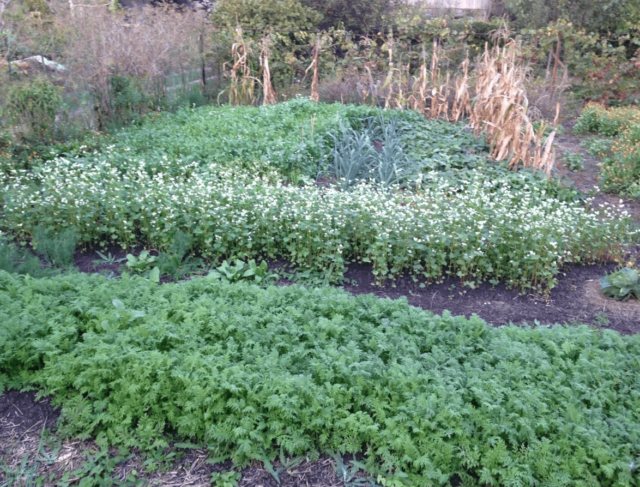

Phacelia prevents weeds from growing
Phacelia flowers in landscape design
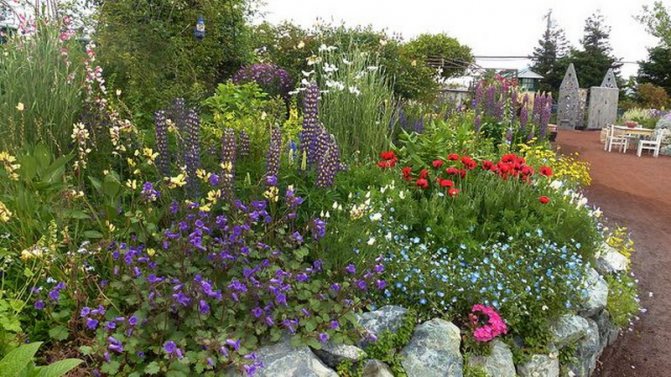

Phacelia in landscape design
Phacelia is planted in mixed beds. The blue-eyed flowers contrast with the dark green of the plant itself. Plant white or yellow flowers nearby: perennial chamomile, Gaillardia, coreopsis, heliopsis, yarrow. It is appropriate to combine with astrium, eschsholzia, lavender, rudbeckia, flax, phlox, bells, lupins, poppy seeds, calendula, mimulus.
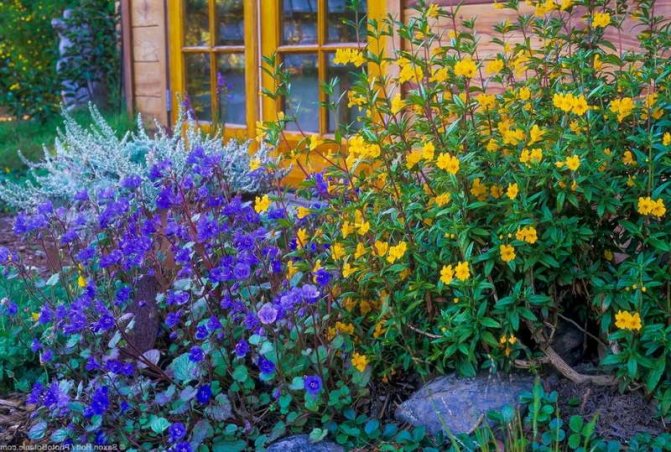

Lipstick and phacelia bellflower photo
Phacelia looks great along the curb, among boulders and stones. It is grown in pots to decorate verandas and balconies. Planting between fruit plants will protect the garden from pests and decorate at the same time. Lovers of Moorish lawns (a kind of flower meadow) will also like phacelia.
Phacelia smells fragrant all summer, bringing a good-natured and romantic mood.
Suitable species for growing
The homeland of Phacelia is America, but this useful and beautiful plant has taken root in our country. Photo of flowers phacelia-siderata:
Of the eighty existing species of phacelia, of interest to gardeners and gardeners are mainly three of them, which are suitable both for decorative beautification of the site, and as a siderat or honey plant.
Consider the description of these types of phacelia green manure:
- bell-shaped phacelia blooms in June, grows up to 25 cm, its flowers resemble intense blue or lilac bells;
- phacelia siderata tansy blooms in May, numerous inflorescences look like ears with very small pink-bluish flowers, the height of the phacelia siderata plant reaches 1 meter;
- twisted phacelia blooms from June to September, its small flowers are collected in curls.
Botanical description
A significant part of the phacelia species are grown as ornamental plants, green manures and honey plants. Phacelia can be grown as an annual or perennial herb and has a branched stem part. As a rule, the stem is erect and bristly hairy. The height of an adult plant, depending on the species, can vary from 20 cm to a meter.
The foliage of the phacelia is whole-edged, it can be represented by opposite or alternate leaves. The presence of a rather short pedicel is characteristic. The flowers are white, purple, blue, azure or yellow. The main flowering phase of the plant occurs from June to mid-September. The duration and time of flowering may vary depending on the species and varietal characteristics.
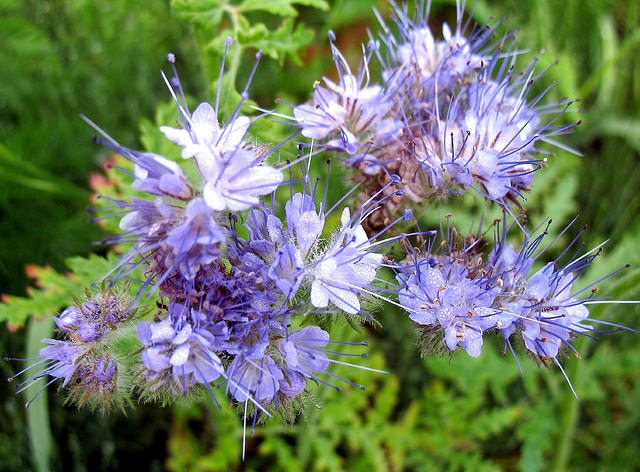

What crops are phacelia used for
Phacelia is the only green manure that has no relatives among plants, so it is excellent as a predecessor or neighbor for all crops, without exception.
Tomatoes
For tomatoes, the ability of the phacelia to prevent late blight and to supply plants with nitrogen, potassium, phosphorus and organic nutrients is of particular importance.
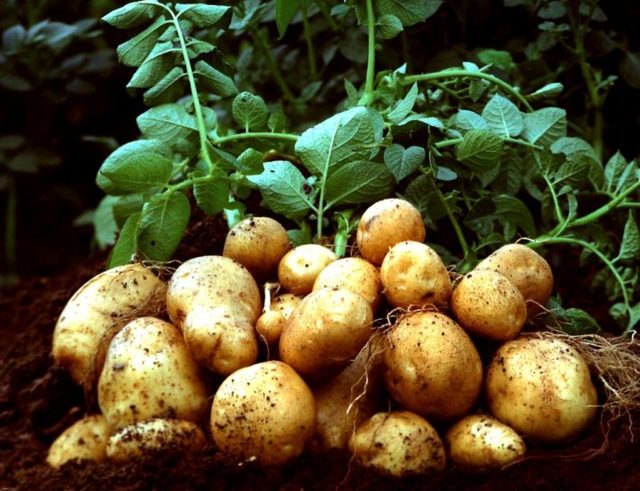

Phacelia is sown next to potatoes to inhibit weed growth
Potatoes
The plot prepared for potatoes is recommended to be sown with phacelia in the fall, and in the spring, half a month before planting the tubers, it should be sealed in the ground. In addition, it is possible to sow phacelia in the row spacing of already spudded potatoes, which will restrain the growth of weeds and protect the roots from the harmful effects of the wireworm.
Cucumbers, pumpkin
Planted in the aisles of cucumbers, zucchini and pumpkins, phacelia, by attracting insects, helps to better pollinate crops and set fruit. Also important for these plants is the ability of the phacelia to supply plants with potassium, phosphorus and nitrogen, to fight root rot.
Cabbage
It is effective to plant cabbage seedlings in the area where the phacelia grows, which will cover the cabbage with its green mass from excess sunlight. In addition, phacelia attracts predatory insects that can rid cabbage of caterpillars, aphids and other pests.
Raspberries
Sown between raspberry bushes, phacelia will ward off garden pests, inhibit weed growth, and attract insects to pollinate the plant.
Pepper
Two to three weeks before planting the pepper, sow the green manure phacelia on the prepared bed. Plant the seedlings in the holes made without removing the green manure. The bushes will take root more easily in a new place, since the light shade of the phacelia will protect them from strong sun and wind, and provide them with nutrients.
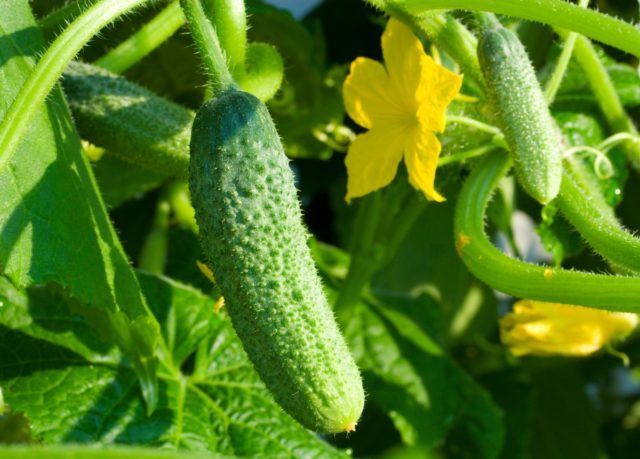

Helps better pollination of phacelia crops planted in the aisles of cucumbers
Sowing purpose
A distinctive feature of the phacelia from other types of green manure is its visual appeal and decorative effect. The plant is characterized by rapid growth and tolerance to low temperatures. The active and fast growth rate of the phacelia allows the plant to be used as an intermediate precursor or as the main green manure plant.
As a result of sowing phacelia before winter, in the spring it is possible to get about 25-27 kg of greenery from a plot of square meter, which can be equated in value to 25 kg of rotted manure. At the stage of decomposition of the green mass of the plant, a significant amount of nitrogen is released. In areas represented by poor soils with nutritional deficiencies, phacelia is grown in the spring-autumn period.
When to plant outdoors
When to sow and when to bury phacelia green manure depends on the tasks assigned to it. This crop has a very wide range of planting dates: from the very beginning of spring to late autumn.
Fall
When to sow phacelia as a green manure in autumn? There are two options:
- It is better to sow green manure immediately after harvesting the main crops, so that the land is restored, saturated with nutrients. Sowing is carried out from late summer to mid-autumn. Phacelia seedlings are not mown before winter, but left on the site, as it can protect the soil from severe freezing and leaching of nutrients from it.
- You can carry out a podzimny sowing of green manure in order to get early spring shoots of phacelia and have time to mow it before planting cultivated plants that are not afraid of the cold.
Spring
When deciding when to sow phacelia green manure in spring, it is necessary to determine what is planned to be done in this area next. If by sowing green manure, the soil is prepared for planting seedlings and heat-loving vegetables, then the phacelia is sown immediately after the snow melts. After 10-15 days, shoots appear, and after another 2 weeks the green manure begins to bloom, then it is better to mow it.
Phacelia as a honey plant is recommended to be sown throughout the spring and summer, after flowering it is better to mow and sow again.
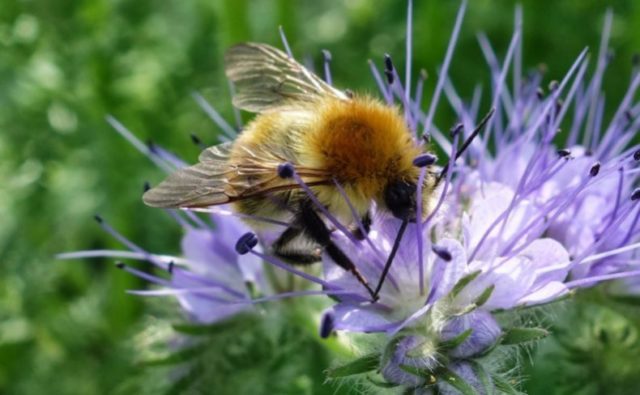

It is recommended to sow phacelia as a honey plant all spring and summer.
Phacelia: description (video)
In order to improve the structure of the soil and to increase the indicators of soil fertility on the site, it is recommended to carry out regular sowing of green manure plants, both in spring and in autumn, for three years. It is necessary to mow the planting of green manure and dig up the soil before the flowering phase. The last time to sow Phacelia is in the last decade of November, without mowing the plants. Thus, it is possible to obtain a significant green mass that can protect the soil, both from freezing and drying out or excessive accumulation of moisture.
Phacelia, after decomposition in the soil, is a light, quickly digestible and highly effective fertilizer, which is enriched with all useful elements and minerals necessary to improve the quality of the soil.
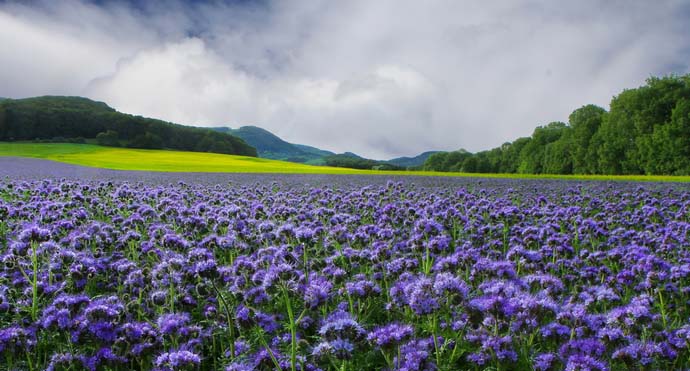

Nuances of planting green fertilizer
Due to its unpretentiousness, the phacelia does not require special planting difficulties.
How to prepare the soil for sowing
Before sowing phacelia, it is worthwhile to clear the soil of debris and loosen it a little, but plowing is not necessary. But if plowing was carried out, then the top layer of the soil must be compacted in order to achieve simultaneous germination of seeds.
Calculation of density and seeding rate
Phacelia seeds have a thin shell, so they are highly germinating and do not need pre-treatment. The seeding rate of phacelia green manure is 150-200 g of seeds per one hundred square meters. With late autumn sowing, the rate usually increases by one and a half times. How to plant phacelia as a siderat correctly, we will consider below.
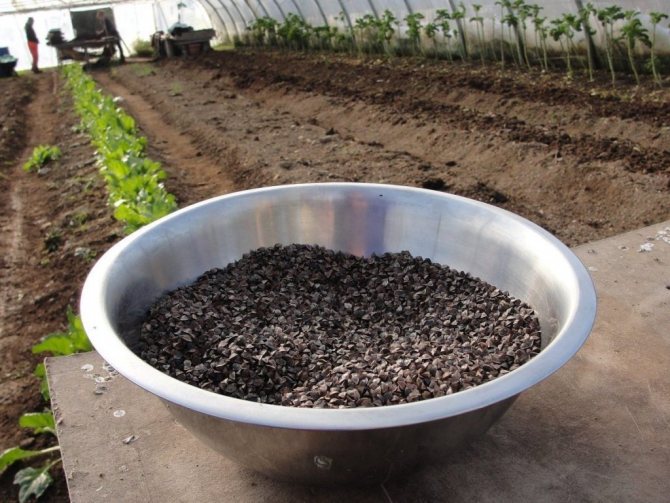

It is worth clearing the soil of debris before sowing phacelia
Types and varieties of phacelia with photos and names
Phacelia bellate Phacelia campanularia
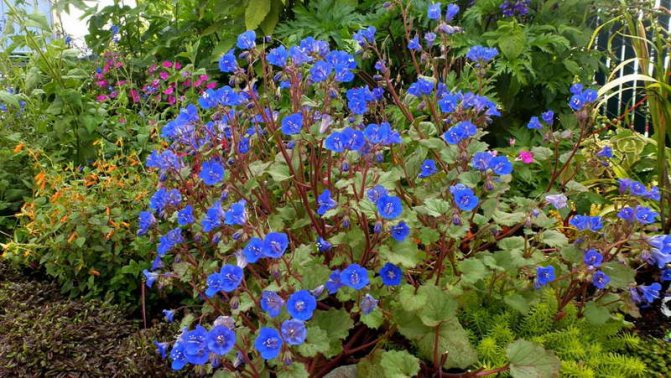

An annual herb 20-25 cm high. Ovate leaf plates with unevenly jagged edges are located on succulent stems. The skin of the shoots is fleecy, reddish. The leaves are green-gray. In diameter, dark blue, almost purple flowers are 3 cm.
Varieties:
California bellflower - gray-green fleecy vegetation is combined with miniature blue bells;
Blue Bonnet - bushes about 40 cm high, bright blue flowers.
Phacelia twisted Phacelia congesta
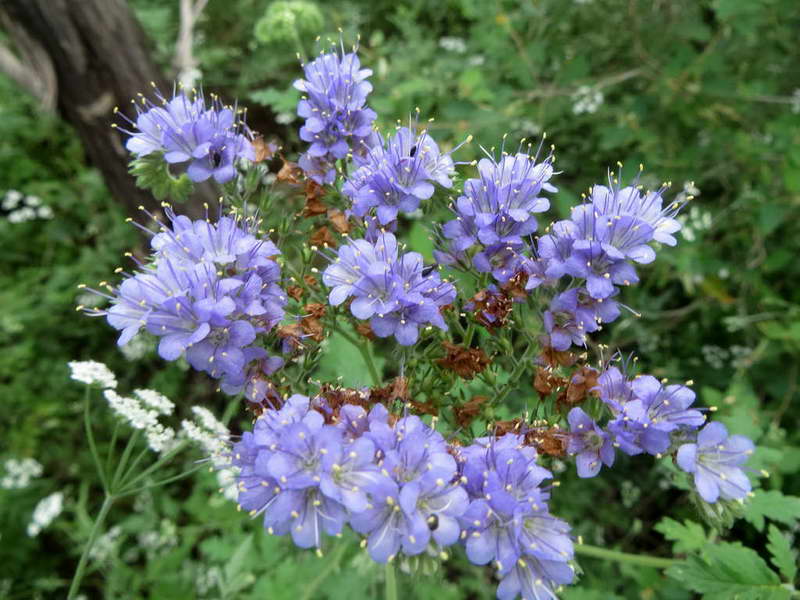

Notable spike-shaped inflorescences twisted by a snail. The flowers are small, blue.
Phacelia tansy or mountain ash-leaved Phacelia tanacetifolia
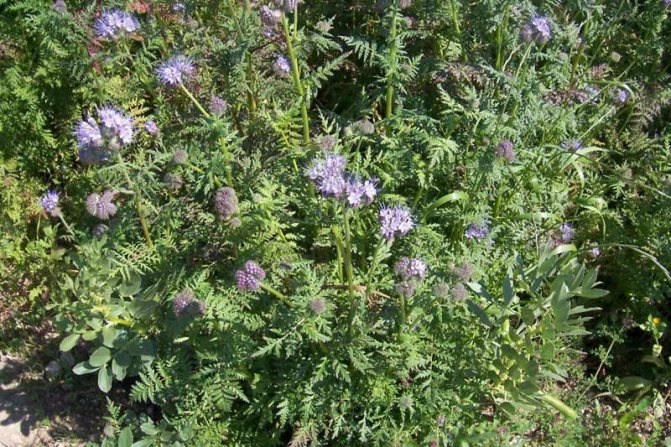

The name is derived from the pinnately dissected leaves. It is this species that is cultivated as green manure, honey plant and fodder crop.One meter tall bushes are densely covered with leaves and inflorescences. The shade of the petals is bluish-blue, but these shy ones are harmonious in flower groups.
General landing schemes
Sowing seeds can be done in two ways: in bulk or in rows. It is not recommended to plant small green manure seeds too deep into the soil, the optimum depth is 1.5-2 cm. Moisture is necessary for their germination, therefore, after sowing, the site is watered abundantly with water. If planting is carried out immediately after the snow melts, then additional watering is not needed.
Wide-row method
When placing the phacelia in the aisles of cultivated plants, they dig a shallow hole, water it with water and evenly cover the seeds, sprinkling them with a little soil. Also, the wide-row method is used when sowing this plant as a honey plant. In this case, a seeder is used, with which the seeds are sown to a depth of 1.5-2 cm, leaving a distance between rows of 15-20 cm.
Sowing continuous
On large areas, loose sowing of phacelia is more often carried out. The seeds are scattered over the site, having previously loosened the ground with a rake, and then they are embedded in the ground with a rake. Small and dark seeds are practically invisible on the soil. In order not to leave empty spaces in the garden, it is recommended to mix the seeds with sand or sawdust when sowing, so they will become more noticeable.
Sowing with legumes
Sowing phacelia together with legumes gives a good effect. This will lead to a noticeable decrease in the number of pea kernels, aphids and other parasites.
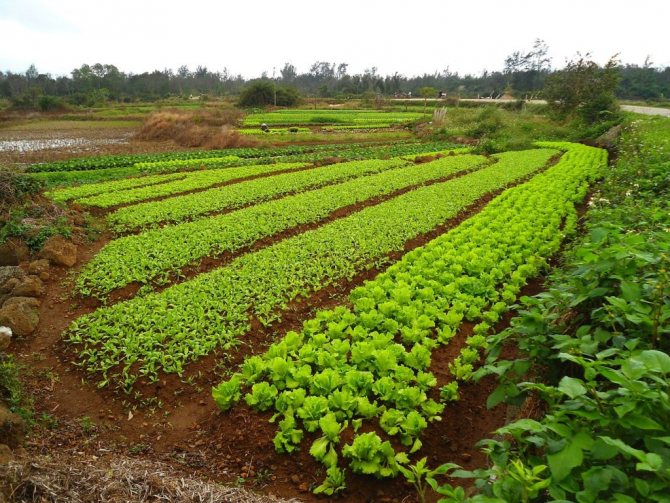

Phacelia grows on any soil
Reviews of summer residents
According to experienced gardeners, sowing phacelia is a fairly easy and convenient way to provide the soil with adequate nutrition. Phacelia has a well-developed root system, perfectly loosening the topsoil and saturating heavy soils with air. According to gardeners, even a single sowing of this green manure on the site has a noticeable positive effect on the quality and quantity of the crop.
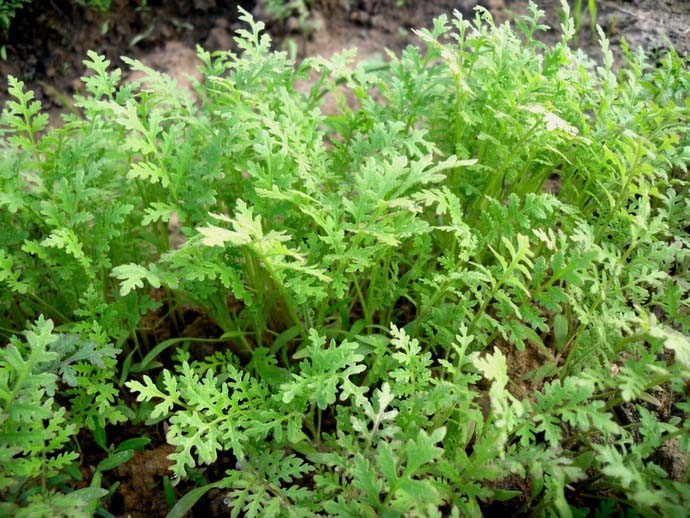

Among other things, numerous observations of summer residents prove the deoxidizing effect of growing Phacelia green manure and obtaining soil with an acidity level closer to neutral indicators. At the stage of active flowering, the phacelia is attractive to pollinating insects., as well as natural enemies of the leafworm, apple blossom beetle and fruit beetle.
With the correct cultivation technology, phacelia can protect garden plantings from wireworms, locusts and nematodes, and also prevents damage from viral and bacterial infections, including phytophthora and rot. Experienced gardeners recommend using the crop in joint plantings with legumes, which will protect garden plants from damage by aphids, weevils and weevils.
Flowering and collecting seeds for subsequent planting
Phacelia is not a perennial green manure, so we will consider how you can independently collect phacelia seeds for the next sowing. Phacelia blooms in stages for 30-40 days: first the lower flowers, and then the upper ones.
It is better to collect seeds from early spring planting, since it is they that ripen to the end and do not deteriorate in rains. Harvesting begins when the seed pod becomes 70% brown, later self-seeding may occur. The greens must be mowed and dried in a ventilated area. Boxes are manually husked at home.
When to mow Phacelia
Phacelia can grow like a weed. She does not need fertilizers, an abundance of watering, protection from pests, diseases, like cultivated plants. It gives more to the land than it takes from it, for which it is valued by farmers. Its seeds can withstand frosts down to -9 degrees, and seedlings are not afraid of cold weather down to -5, so there is no need to worry about early or late planting.
Flowering is observed approximately 4-5 weeks after sowing.Siderat blooms for about 35 days, in stages, that is, first the lower buds bloom, and then the upper ones. Seeds are recommended to be collected from plants that were sown in spring, they are well stored and do not deteriorate. When the seed pod turns brown, you can harvest the seeds. If you miss the time, the seeds will scatter themselves on the ground, so it's better to do this a little earlier than later.
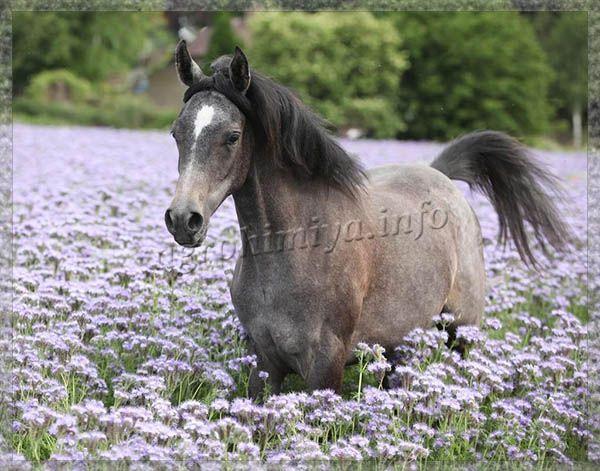

Phacelia are often used to feed livestock
Important!
For phacelia seeds to germinate well, it is best to use them immediately after harvest or the next season.
To collect the seeds, it is worth mowing the greens and hanging them at home, and putting a cloth under it. As it dries, the seed pods will open, and the seeds will fall on a cloth. If the seeds need to be obtained quickly, then the boxes are simply peeled at home by hand. This is not difficult to do.
As for the remnants of the phacelia - the roots and hemp left after mowing the greens, they must be dug up together with the ground on a full bayonet of a shovel. And after 2 weeks, you can sow cultivated plants on this site.
Reviews of gardeners about Phacelia as a siderat
Phacelia as a green manure is used by many gardeners. Their opinions about this culture and its benefits are presented below.
- Valentina Comb: “On my site I often use green manure. Most often I choose mustard, alfalfa and phacelia. At the same time, it is the phacelia that I like most of all. It is good for the soil and already growing crops. In addition to feeding, improving the quality of the earth, phacelia protects plants from many pests, diseases, and attracts bees during flowering. I plant 1-2 times a year, alternating plots. Since I started growing it, the yields of different crops have increased significantly. "
- Maxim Erokhin: “I sow on the green manure every year. Phacelia is usually purchased via the Internet, since it is not always available for sale. I sow in spring, summer and autumn in different areas. The plant is very useful, easy to grow. After it, rot, late blight, pests such as wireworm and aphids do not appear. I think this is the best option for garden crops among green manure crops. "
- Egor Krivoguz: “I plant phacelia and mustard alternately, sowing in different areas. They grow quickly, they improve the land, but you need to sow thickly, otherwise weeds will germinate. From leaving only watering is required, nothing else is needed. The main requirement for growing phacelia is to harvest it on time. After the seed pods open, the stem becomes tough and rots for a long time in the ground. So this moment needs to be monitored. My wife and I cut the stems as soon as the seed pods start to turn brown, and immediately dig it. "
Growing green manure for seeds
In order not to buy green manure seeds every year, you can grow them yourself. For this, part of the spring plantings is not mowed, but left to bloom. We will tell you how to collect phacelia seeds at home - by hand.
The flowering period of the culture lasts 30–45 days, each flower is pollinated by bees within 2–3 days after blooming, respectively, and seed ripening is extended in time. Cleaning begins when about 70% of the curls in the bunches-inflorescences are dry and brown. They are carefully cut, making sure that the seeds from the lower part of the inflorescence do not fall off - here they are the largest and highest quality.
Small sheaves are knitted from cut plants and hung to dry. After 3-5 days they can be threshed. The plant is fragile, the capsules quickly collapse, the seeds spill out easily.
After threshing, the seeds are dried in the sun, blown to cleanse the litter. There is no need to do this scrupulously, since during sowing they are still mixed with sand.
Phacelia is a herbaceous plant native to the southwestern United States (California) and Mexico. There are 186 species and varieties of phacelia, including annuals and perennials. Most of this list includes wild species.In the fields and in the gardens, phacelia is planted as a siderat, when to sow and how to care for the crop, you can find out from agronomists working in a particular region, as well as from private gardeners who grow this herb.
Siderata enrich the soil with useful compounds and restore its quality. The culture is also grown as an ornamental flower and honey plant. In Europe, this plant can be found along roads and on the outskirts of fields, where it grows like a weed.
Preparation of nettle infusion
The tool is actively used in gardening. It is saturated with nitrogen and other valuable elements. Nettle infusion is prepared as follows. Take a bucket with a volume of 10 liters, fill it with weeds by 1/3. The mixture becomes usable after 10 days. To carry out foliar dressing, it is necessary to dilute it with water in an amount of 1: 10. If it is necessary to apply to the leaves, take a ratio of 1: 20. To increase efficiency, add mullein.
Some summer residents use mineral agrochemicals. The products contain substances that the main crop needs. Potassium and phosphorus mixtures can be added to the nettle infusion. Nettle is combined with phacelia, wormwood, horsetail. A solution of 1: 20 is used for spraying trees and shrubs. Such a composition is unsuitable for long-term storage. The maximum shelf life is 2 weeks.
Weed infusion includes clover, mustard, wormwood, lawn grass. Plants are crushed and poured with a small amount of water. Dolomite flour is added to the mixture, 100 g per 10 l is required. Fertilizer gives off an unpleasant odor. For neutralization, drugs are used.
How to collect your seeds
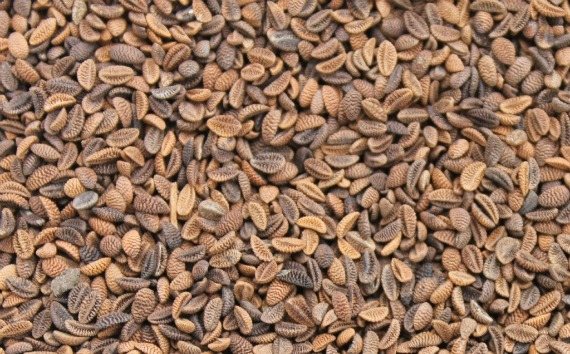

To be able to sow phacelia in the new season from your own seeds, they must be properly prepared. The plant has one feature - the largest percentage of germination can be obtained only from plant seeds that were planted in spring.
It is at this time of the year that the process of maturation of seed material occurs fully. Therefore, intending to get your own seeds, you should try to manage the spring sowing in a timely manner. In order to get an accelerated and high-quality flowering and further ripening of the seed bolls, crops can be watered several times.
The seeds obtained as a result of spring planting are larger in size, which has a positive effect on their storage and further germination. It is necessary to collect seeds at the end of summer. In warm regions, bolls ripen earlier - at the end of July.
To collect seeds in a timely manner, you need to pay attention to the following signs:
- the spikelet has already changed its color;
- the capsule is more than half brown;
- if you rub the seed capsule in your palms, the seeds fall out of it.
In the event that the collection was carried out ahead of the allotted time, the boxes will have to be dried. If the collection of seeds is late, time can be lost, as a result of which self-seeding will occur and it will no longer be possible to obtain planting material. If the harvesting of seeds was carried out too early, drying will not help, since the seeds will turn out to be immature, unsuitable for long-term storage.
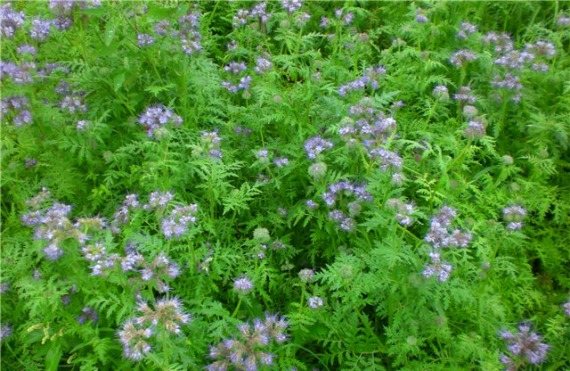

Having decided on the exact timing of collection, the summer resident needs to take with him a container for cut phacelia spikelets, scissors or pruning shears. It is recommended to carry out blank work with gloves. It is imperative to harvest phacelia seeds in dry weather. After the spikelets are collected, they are laid out to dry on newspaper, cardboard sheets.
The raw materials must always lie in a thin layer; in the process of drying, the spikelets are turned up. Dry the seed pods in the shade under a canopy. You can also use a living room or a shed for this purpose, but you need to take care of high-quality ventilation.
The dried raw materials are folded into a dense linen bag, tied and pounded on it with a suitable stick. A few minutes should be enough for the seeds to separate.At the final stage of harvesting seeds, wind is carried out using a special winnower, or using a sieve with large cells. The bulk of the plant waste can be separated using a sieve.
The remaining seeds, together with small debris, are poured from one container to another from a great height. The work must be done outside. In the process, the wind will remove all unnecessary particles. For good cleaning, sprinkle the seeds 3 to 5 times.
Planting material is stored in cloth bags or plastic containers. Do not use plastic bags, they will spoil the seeds. The seed storage room must be dry and cool. The seeds should also be kept out of sunlight.
On a note! Some summer residents have adapted to keeping seeds in the freezer. In the spring, the planting material is taken out of the freezer and kept at room temperature for 15-20 days without removing it from the package.
Agrotechnical features of cultivation
This culture grows well in the southern regions, in the non-black earth, in areas of risky farming. All types of soils are suitable for cultivation (peat, loamy, sandy loam, podzol and black soil). Phacelia also grows on soils containing gravel and pebbles.
The tansy phacelia is a cold-resistant plant. Seeds are sown as soon as the snow melts, and even in September, before the first frost. Seed material retains germination when the soil freezes to minus 9 degrees, seedlings survive when the air temperature drops to minus 3-5 degrees.
Phacelia care
Phacelia is considered a hardy and picky crop. It is characterized by resistance to drought, irrigation will be needed only in case of prolonged absence of precipitation - if the soil surface cracks. In the initial 2-3 weeks of seedling growth, weeding and loosening of the soil will be required. Then this procedure is no longer required.
To improve flowering, rapid growth, it is recommended to feed the crop 2 times per season, using universal mineral complexes for this. The opening of the buds occurs one month after sowing.
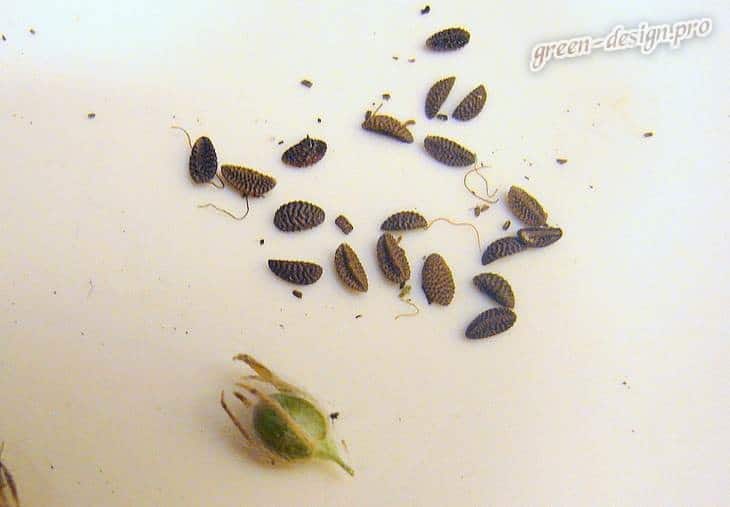

Seeds begin to be harvested after half of the seeds are brown. The main thing is not to miss this moment, since the ripened achenes open naturally.
Breeding features
Cultivation is carried out immediately in open soil. Young seedlings are able to withstand subzero temperatures (not lower than -9 ° C). You can sow a plant for the winter, this is done in November (but before the onset of frost). In the spring, it is allowed to sow from mid-March to the second half of April.
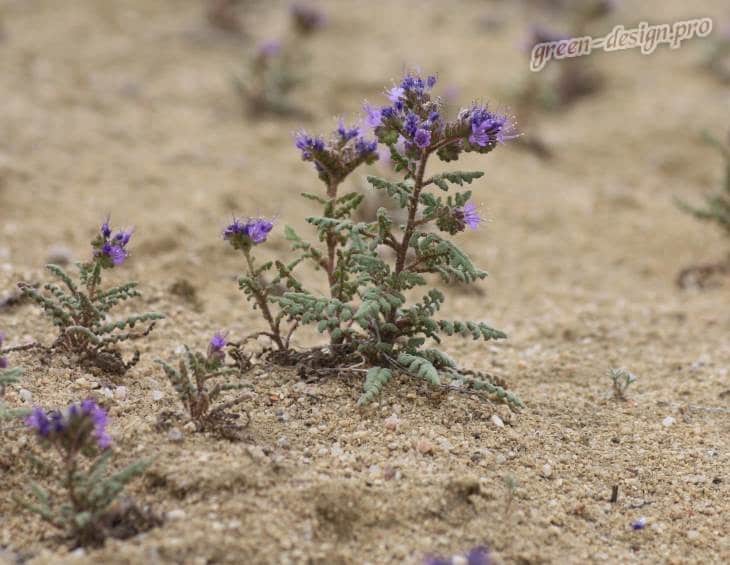

Phacelia can be planted anywhere in your area, the plant takes root well, the main thing is to water it in a timely manner.
In July, you can sow the plant a second time. Since the seeds are small, they are made into a mass based on sand and sawdust. 100 g of seed is sufficient for a 60-80 m² plot. The distance between the seedlings is 4-7 cm.
Phacelia seed storage
Phacelia seeds do not lose similarity for 5-8 years, which makes it possible to make a stock of seed for future use. It is recommended to use cloth bags or plastic containers that are hermetically sealed. Plastic bags are not used for these purposes - in such packaging, the phacelia seed will quickly deteriorate and lose its similarity.
It is important to choose a cool room with low humidity for storing seeds. The air temperature should not exceed 10-15 degrees. If storage takes place in linen bags, be sure to ventilate the room 2-3 times a week.


During storage, make sure that the room is dark. Sunlight can provoke germination, so it is recommended to keep the seed packages away from windows or doors.
The most effective way to store the seed of a crop, as many landowners have seen, is to send containers with seeds to the freezer after final drying. Low temperatures do not affect the similarity in any way, allowing a significant increase in shelf life. Even after 5-8 years, the seed material will give even shoots, from which powerful plants will grow.
The only rule that is recommended when storing phacelia in the refrigerator is not to remove the seeds. Temperature changes will adversely affect the seed condition.
Soil-forming and soil-protecting qualities
Phacelia is a rather tall plant, growing on average 70-80 cm. Phacelia stems are green, in places with a reddish tint, covered with short hairs. Leaves with a strongly dissected, feathery leaf blade, triangular in outline. Thanks to the leaves, the bushes look delicate. The inflorescence is a dense panicle, the flowers are collected in a tight curl. Corolla is five-lobed bell-shaped or funnel-shaped, 2.5-3 cm in diameter. Sepals strongly pubescent, tightly fitting the corolla tube. Five very long purple stamens with dark anthers. The petals themselves are light purple or purple. The fruit is a nut. Seeds remain viable for 3-4 years.
Phytosanitary qualities
A week later, I sow the garden again. The algorithm repeats itself until autumn. I leave the last sowing for the winter. In spring, the soil turns out to be loose, light, saturated with oxygen and useful inhabitants.
- Crops of phacelia "mow" at the root. Then I fill in with a preparation based on microorganisms, for example, “
- In early spring, as soon as the snow melts, I loosen the soil in the beds with a flat cutter to a depth of 5 cm. I sow seeds randomly. The norm is 200 g per 1 hundred square meters. Since the seeds are very small, it is very difficult to adhere to the norms. You can mix them with sand and scatter like this.
- Having decomposed in the soil, the phacelia biomass becomes an easily digestible fertilizer, saturated with nutrients, mineral compounds and microelements. At the same time, the soil is replenished with organic matter and humus.
- Harvesting ends at the beginning of the flowering of the plant, since later the amount of nutrients and nutrients will significantly decrease. It is necessary to prune the phacelia with a cultivator or a Fokin plane cutter; it must first be watered with a solution of EM preparations.
- You do not have to worry about the growth of phacelia in a mixture with other fast-growing forage crops, since it takes place at the same level as normal plant growth. And in a mixture of phacelia with legumes, it gives a greater yield of nutrients and useful substances.
- Phacelia is an excellent phytodoctor
What is composting?
The procedure takes 2 months. After this time, the plant mass becomes ready. When it decays, it loses a certain amount of ammonia, as a result it becomes less harmful. The composting time depends on the components that make up the substance. When using a herbal mixture, precautions must be taken.
Lupine is used as compost. This culture absorbs a lot of nitrogen and sprouts quickly. During the period of active growth, lupine forms a powerful stem. Thanks to him, the summer resident receives a large amount of compost. Lupine remains viable even if the temperature drops to extreme levels.
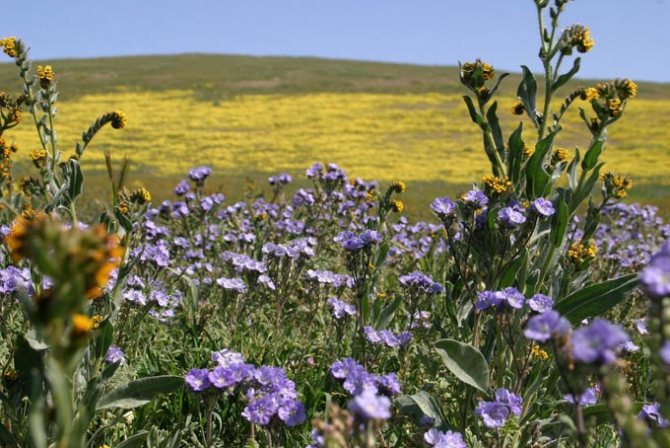

The method of thorough enrichment of the site with humus using phacelia
In order to qualitatively fertilize and cultivate the site, it must be sown with green manure throughout the season, from spring to autumn:
- Make the first sowing at the earliest possible date.
- Wait for the flowering period, mow the grass, pour the preparations "EM1", "Biovit", "Baikal - M1" to accelerate the decomposition process.
- After a week, sow the garden again, do the same operations.
- Continue sowing until late autumn, the grown greens, without mowing, leave until spring.
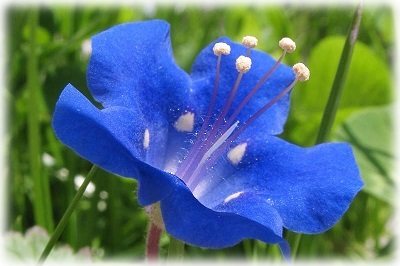

Sowing phacelia as a green manure in this way will give an excellent result by spring - loose, water and air permeable soil saturated with humus.
If the method seems costly to someone, requiring a large number of seeds, it does not matter, it is not at all difficult to get your seeds, leaving a small area of flowering phacelia, let the seeds ripen, then dry them and thresh them.
In any case, the improvement and enrichment of the soil with green manure is more profitable than humus, with which diseases and many stubborn weeds are often brought in.
Benefits for the soil
The annual cultivation of vegetables inevitably leads to depletion of the soil, as a result of which their productivity decreases, pathogens accumulate in the ground. One of the solutions to this problem is the cultivation of green manure on the plots, which effectively increase the fertility of the soil, filling it with nutrients, and improving its structure.
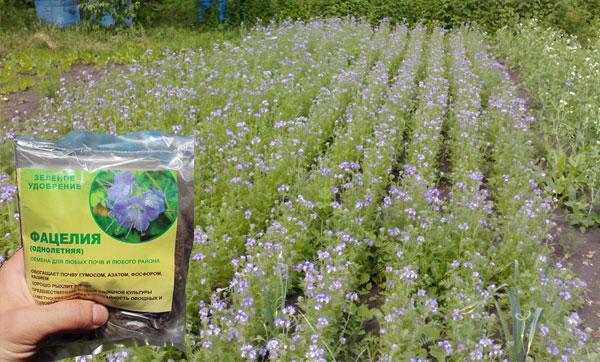

The use of phacelia as a fertilizer allows you to significantly increase soil fertility in just 1 season, and if you sow it regularly, the effect will be fixed. Green manure is not inferior in nutritional value to manure. Plant roots make the earth loose, increase its air and moisture permeability. Phacelia prevents the growth of weeds, the reproduction of nematodes, the appearance of wireworms. It grows in soil of any type and acidity, is unpretentious, resistant to drought, does not get sick or infect neighboring plants, and even heals the soil, as it has bactericidal properties.
Sowing phacelia can be done throughout the warm season, as well as sown before winter. It grows quickly, accumulates mass in 1-1.5 months, it has coarse leaves and stems, which, once in the ground, quickly rot.
Some rules
It should be said that not all conditions can be favorable for certain plantings. However, with some effort, using the right methods, high yields can be obtained fairly easily. If you do not know some of the features of growing "green fertilizers", you can make a number of mistakes, as a result of which all the work will go down the drain. In order not to be disappointed in the method of enriching the land with useful compounds by planting green manure, it is necessary to adhere to the following recommendations:
- Crops must be mowed on time. Otherwise, the stems will become rough, which will significantly slow down their rotting in the soil. Not completely decomposed biomass, in turn, can become a source of fungal and viral diseases.
- To protect vegetable crops from weeds, it is necessary to sow phacelia not in rows, but in bulk.
- Tops are trimmed 2 weeks before the main plantings are planted.
- Plants that belong to the same family as phacelia and other green manure should not be sown next. This is due to the fact that common pests can persist in the soil.
- If the planting of a crop is carried out to restore fertility, then the "green fertilizers" should be mowed with a flat cutter or oblique, trying not to damage the root system.
- Winter green manures that were sown in late autumn are not recommended to be cut before the onset of frost. It is more expedient to leave them until next spring. In this case, there will be no need to plow the land, since it will be quite loose anyway.
Benefits of Liquid Fertilizers
Siderata are used instead of compost. The main culture quickly absorbs their components, due to which it grows better. Formulations prepared on the basis of cut grass reduce the acidity of the soil. If a gardener uses green manure, the soil receives not only valuable substances, but also microorganisms that protect it from pests.
Preparation of a useful composition
1 bucket with a volume of 10 liters requires 3 kg of green manure. Use phacelia, mustard, rye. Plants with roots can be weeded out. Seeds will also benefit. The bucket is filled with grass, water is poured, covered with polyethylene. To improve gas exchange, you need to make several holes in the film.Scotch tape is used for fixation. The mixture is infused for 7 days, after which it becomes ready. The fertilizer emits a characteristic odor.
The solution is combined with water in proportions of 1: 10. An increase in concentration is unacceptable, as the culture may suffer. If there is a desire to make a stronger composition, you need to test it on one plant. The prepared mixture can be used many times. The remaining grass is combined with water.
Gardeners share their experiences.
- To get a high-quality complex fertilizer, you need to use chamomile, alfalfa, nettle, shepherd's bag. Bone meal is added to the mixture.
- Dandelion is also used for the preparation of fertilizers. The herb is a green manure for cabbage.
- Unlike flowering crops, cereals take longer to decompose, and therefore are rarely used for liquid fertilization.
- Fertilizers with grass can be applied in the fall.
- To speed up the maturation of the solution, add urea.
- If you water the garden with nettle infusion, there will be more earthworms.
An important point
Do not overtighten with the incorporation of green mass. It is more expedient to carry out this work within the first week from the beginning of flowering. First of all, grooves should be dug in the aisles. Their depth is about 10 cm. After that, it is necessary to cut the plant slightly below the soil and lay the greens in the prepared furrows. Organic matter should be lightly sprinkled with compost or garden soil. Some summer residents simply mow the phacelia with a sharply sharpened flat cutter, deepening it 2-3 cm below the soil surface, and then leave the greens to decompose right on the garden bed.
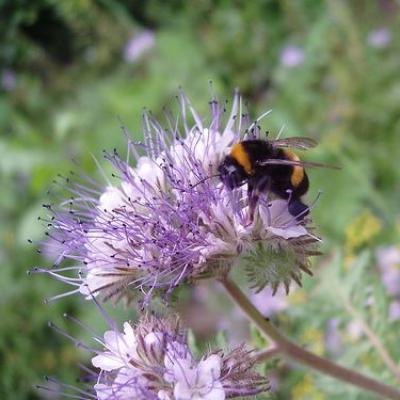

Beneficial properties for soil and plants
Siderata herbs - phacelia, lupine, clover, alfalfa and others - enrich the soil with nitrogen, which is necessary at the initial stage of growth of garden crops - vegetables, berries, fruit trees. The tissues of the green manure contain potassium and phosphorus, which are necessary for fruit setting and root growth. In terms of the ratio, green fertilizer is superior to manure, since it contains no phosphorus. It has to be added in the form of mineral salts.
But the most important thing is organic matter, the amount of which in the soil affects its characteristics. If there is little organic matter, the soil is susceptible to water erosion and weathering. The color of the ground changes from deep black to gray. Good bacteria feed on organic matter, if there is little of it, microorganisms die, and the soil is even more depleted.
Video: An interesting story about phacelia
With a change in acidity in the earth, lovers of an acidic environment start up - nematodes and wireworms. There is no reason to expect a good harvest after them. Fungus and bacterial root rot grow on diseased plants.
All the consequences of the depletion of the soil fertile horizon can be cured by sideration, planting companion plants as intermediate or independent crops.
The method does not contribute to the accumulation of nitrates and is completely harmless to plants and humans.
Drying spikelets is a prerequisite
Immediately after collection, send the spikelets for drying. To do this, use sheets covered with cardboard. If phacelia seeds are harvested annually in large quantities, it is recommended that special frames with stretched nets be prepared in advance. Spread the plant materials in a thin layer that does not exceed 10-15 cm.
Drying under a canopy, in partial shade. Bright sunlight provokes ripening and cracking of the capsules, which can lead to the loss of seeds - they scatter far to the sides. In the process, stir spikelets regularly, allowing them to dry evenly from all sides. You should not do this with your bare hands - the sharp edges of the boxes can damage the skin.
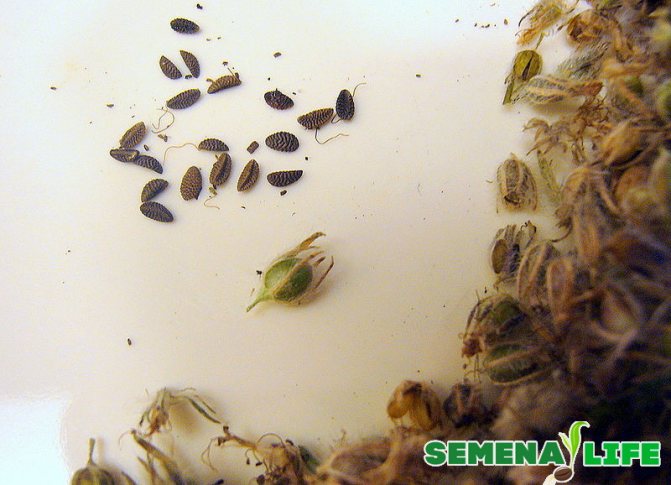

If drying spikelets is carried out indoors, take care of ventilation. Lack of ventilation will negatively affect the quality of the seeds and can provoke boll rot or mold.The extracted seeds are no longer suitable for sowing - the similarity decreases sharply, and even full-fledged plants cannot be obtained from germinated grains.
Vegetable compatibility with green manure
Phacelia goes well with any crop. Protecting the soil from pests, making the soil healthy from infections, phacelia relieves the gardener from strict adherence to the rules of crop rotation, if the possibilities of the site are limited.
But other green fertilizers do not have such abilities, therefore, compatibility and crop rotation must be taken into account:
- rapeseed, mustard, oil radish are sown before and after any crops, except for related ones, cabbage;
- lupines, peas, vetch, other legumes - away from representatives of their family, but alternate with potatoes, other nightshades, cucumbers, pumpkins, zucchini;
- cereals are suitable for all crops except sunflower.
Green manure for the garden is an indispensable component of a rich healthy harvest, if you follow the rules of agricultural technology.

